CHINESE FURNITURE SEEMS TO BE OF 2 FORMS; ELABORATELY CARVED AND INLAID WITH GEMS AND MOTHER-OF-PEARL OR SLEEKLY SIMPLE.
THINK CHINESE FURNITURE AND IT IS A TOSS UP BETWEEN TRADITION AND TRADITION!
YES, THE 'CLASSIC' CHINESE FURNITURE IS BOTH EXTRAVAGANT AND BASIC!
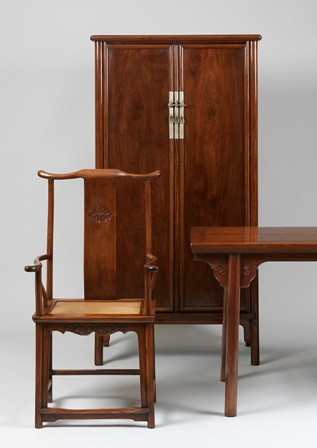
A stunning set of Huanghuali furniture from Ming and early Ching dynasties of armchair, cupboard and table with recessed legs. Most Malaysians are unfamiliar with such furniture devoid of carvings, inlays and ornamentations as most of us tend to prefer the Nyonya Baba type of heavily decorated furniture symbolising wealth and social standing.
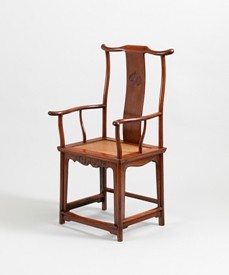
Huanghuali high yoke-back armchair
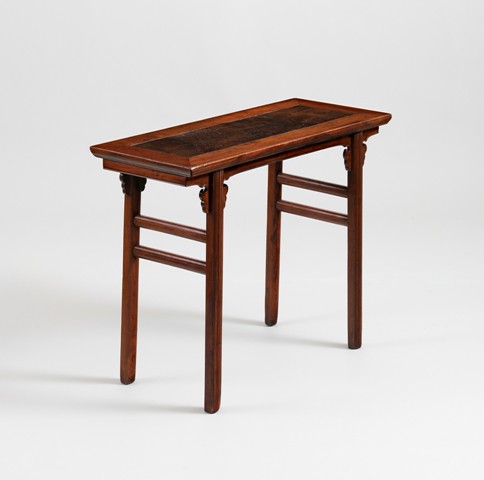
Small huanghuali and burlwood wine table
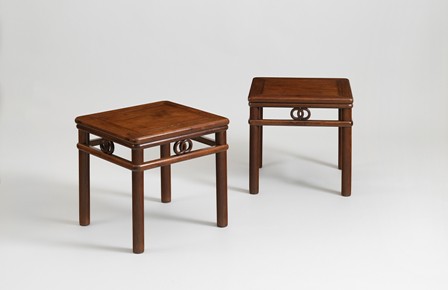
Pair of huanghuali stools

Huanghuali painting table
MOST MALAYSIANS ARE FAMILIAR WITH THE ELABORATE VERSION SO FAVOURED BY THE NYONYA AND BABA COMMUNITIES IN MALACCA, PENANG AND SINGAPORE. THINK OF THEIR NYONYA WARES WITH THE COLOURFUL FLOWERS, DRAGONS AND PHOENIXES AND THEIR FURNITURE ARE IN THE SAME ILK!
Purists and some connoisseurs insist the Golden Age of Chinese furniture ended with the ming dynasty and lament the introduction of garish, heavily carved and colourful furniture so beloved by the succeeding Ching or Manchu dynasty. By the early 20th century when the Ching dynasty collapsed to republican and later communist forces and the last Emperor Puyi was booted out of Forbidden City in 1924, this style hadbecome so heavily entrenched in the western psyche it became representative of all Chinese furniture.
Even today, most Malaysians prefer the elaborately carved, heavy teakwood or rosewood furniture inlaid with mother-of-pearl or semiprecious stones or even jade. Personally, I also like this style of flamboyant, eye-catching and often spectacular furniture that commands instant attention and respect! I have an entire set consisting of settees, chairs and side tables elaborately and expensively carved with coiling dragons and chilin handles, assorted phoenixes, Buddhas, lohans, Eight Immortals and floral displays of mother-of-pearl! I love them and they occupy the central space in my condo. I sit on the 3-seater settee while I work as Dedione Kee the darling French poodle sits (usually sleeps) on my right while a stack of 'To Do' press kits and magazines are piled on my left.
I don't care if purists declare I am a philistine with bourgeois taste of the newly rich!
Well, I am never the sort to take such things lying down so I condemn my opponents as deadly boring with no colour sense and if they are so concerned about minimalistic purity and simple harmony, they should squat and sit on the floor cross-legged like the ancient Chinese did and sleep on woven reeds and porcelain pillows instead of Dreamland, Dunlopillo and memory foam mattresses.
Having said that, I must admit I do admire Ming furniture for their, yes, simplicity and sleekness that look so good in contemporary homes. Of course I would not buy them to decorate my house but I must say they look so stylish they could well be copies and replicates made yesterday as they blend in so well with modern homes.
Ming furniture are devoid of ornamentation and nails as they are so well hand crafted each joint fits each other perfectly. There are no carvings of dragons nor plaques of marble or inlays. Made of the revered huanghuali wood (hence the name of this furniture genre) or zitan wood, these Ming furniture find favour with collectors weary of ornate decoration and ostentatious displays of wealth.
So those enamored with this sensibility must pencil in 3 to 25 November and book a flight to London, the greatest city on this planet, to view and buy a superb collection of Chinese furniture featuring huanghuali, the most coveted of all Southeast Asian hardwoods.
ESKENAZI TO SHOW CHINESE HUANGHUALI FURNITURE IN NOVEMBER
Huanghuali table with recessed legs
Pair of huanghuali side tables
Stunning huanghuali round corner cabinet
A superb private collection of Chinese furniture, all made of the South-east Asian hardwood called huanghuali, will be exhibited at Eskenazi, one of the world’s leading dealers in Chinese works of art, at 10 Clifford Street, London W1, from Thursday 3 to Friday 25 November 2011. The exhibition will coincide with the 14th Asian Art in London from 3 to 12 November 2011, an annual event that unites London’s Asian art dealers, major auction houses and societies in a series of selling exhibitions, auctions, receptions, lectures and seminars that attract visitors from around the world.
The history of Chinese furniture dates back some two and a half thousand years, the designs gradually evolving over the centuries and reaching their apex in the late Ming and early Qing dynasties from 1600 to 1700, the classic period from which come all the pieces in the Eskenazi exhibition. At this time a convergence of styles, newly available imported exotic hardwoods such as huanghuali and zitan and an affluent scholar and merchant class led to the creation of some of the finest furniture ever made. Although created hundreds of years ago, its clean modernist lines make it extremely popular today with both western and Chinese collectors.
The ancient Chinese, in common with other cultures, knelt or sat cross-legged on woven mats surrounded by such furnishings as low tables, screens and armrests. Raised seating began to be developed during the 2nd century AD with the spread of Buddhism from India. Stools proliferated through every level of Chinese society and were not solely the seat of the wealthy – while they could convey rank and importance they also served as a more intimate form of seating whereby scholars could sit together on the same level. Stools were also the most varied and used forms of Chinese furniture and among the examples to be shown by Eskenazi is a rare pair of huanghuali stools (deng).
There are two very important chairs in the exhibition, both showing the traditional soft seat construction, each an example of a highly desirable type. One is a high ‘yoke-back’ armchair (sichutouguanmaoyi), so called because of the curving elements projecting from the top rail and the other is a ‘horseshoeback’ armchair, its descriptive name self-explanatory, finely carved with a crane inside a roundel on the back splat. There are two similar, substantial round-corner cabinets (yuanjiaogui) made of beautifully figured panels of huanghuali, both with internal drawers and shelves, one constructed with a central stile separating the doors, the other without.
The range of tables include some very rare types. All demonstrate the mastery of the Chinese craftsman over his material and the highly skilled joinery essential to create these seemingly unfussy, light but sturdy, strong yet elegant utilitarian works of art that have survived for hundreds of years without a screw or a nail in their construction. Of the tables, the small Ming wine table with its decorative burlwood panel (that would have been cut from a large, diseased growth on another, different type of tree), the extremely rare pair of side tables with their ‘wraparound’ elements (banzhuo) and the large, beautifully balanced painting table with its openwork apron (tiaozhou) are particularly worthy of mention.
The joinery system and decorative styles of Song furniture laid the foundation for the technical and aesthetic perfection of the classical furniture of the late Ming and early Qing dynasties made from the new exceptionally durable and beautiful South-east Asian imported hardwoods. Valued for their natural beauty, the expensive, richly-grained hardwoods were finished with only wax. This classic furniture is characterised by simple, elegant structures with fluid lines, balanced proportions and concealed joints. As the supply of imported hardwoods was depleted during the late 1700s, the high technical and artistic standards of the previous two centuries were largely lost. The pure and simple lines and integrity of classical Chinese furniture gave way in the 19th century to a greater concern with ornament for its own sake.
Eskenazi’s exhibitions are always eagerly awaited for the beauty and rarity of the objects and this elegant furniture is no exception. Since the family business was founded in Milan in 1925, the Eskenazi name has become synonymous with expertise in oriental art. Giuseppe Eskenazi, who has been head of the business for over 40 years, has an unrivalled reputation for his knowledge and love of the subject and clients have included over seventy of the world’s major museums as well as private collectors.
Exhibition title: Chinese huanghuali furniture from a private collection
Dates: 3 to Friday 25 November 2011
Opening hours: Monday to Friday, 9.30 am to 5.30 pm
Saturday 12 & 19 November, 10 am to 1 pm
During Asian Art in London:
Saturday 5 November & Sunday 6 November, 10 am to 5 pm
Catalogue: The exhibition will be accompanied by a scholarly, fully illustrated catalogue.
Price £25, $40 (plus p&p)


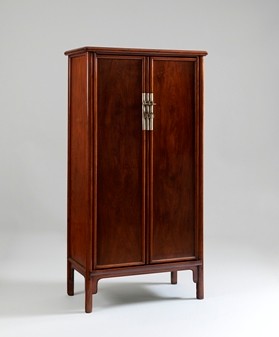
5 comments:
Why don't you come and have a look at my collection of HHL furniture here in Penang. London is too far!
Know anyone in kuala lumpur with experience to differentiate old and new huanghuali furniture.
yang
Yang, call me on 0164263565 if you still require some help. SHIBAPIN
Found your blog again. Tried calling your mobile number no answer. If you are in Kuala lumpur, would be great if you can give me a call at 019-3113221. Cheers
yeoh(yang)
I m interested to buy. Any for sale?
Post a Comment